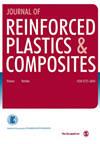异质结构三维 MXene/短碳纤维可提高环氧树脂复合材料的热性能、机械性能和摩擦学性能
IF 2.2
3区 材料科学
Q3 MATERIALS SCIENCE, COMPOSITES
引用次数: 0
摘要
聚合物复合材料在摩擦材料领域发挥着至关重要的作用。然而,恶劣的环境对其应用仍是一大挑战。为了改善环氧树脂的热性能、机械性能和摩擦学性能,我们制备了三维 MXene/短碳纤维(SCF)。当 MXene 与 SCF 的质量比为 1:150 时,MXene 在强氢键作用下均匀地锚定在 SCF 表面,形成稳定的异质结构和丰富的表面官能团。由于 MXene 与 SCF 之间的良好协同作用,改性环氧树脂复合材料表现出优异的机械和热性能以及高导热性。此外,它还具有优异的摩擦学性能,2 小时内的平均摩擦系数为 0.44,比磨损率为 3.0 × 10-6 mm3-N-1 ⋅m-1,分别比环氧树脂降低了 35.3% 和 97.1%。本文章由计算机程序翻译,如有差异,请以英文原文为准。
Heterostructured three-dimension MXene/short carbon fiber to enhance thermal, mechanical and tribological properties of epoxy composites
Polymer composites play an essential role in the field of friction materials. However, severe environment is still big challenges for their application. Three-dimension MXene/short carbon fiber (SCF) was prepared to improve the thermal, mechanical, and tribological performance of epoxy resin. When the mass ratio of MXene to SCF is 1:150, the MXenes are uniformly anchored on the surface of SCF under the strong hydrogen bonding interaction, leading to stable heterostructure and abundant surface functional groups. Owing to the excellent synergy between the MXene and SCF, the modified epoxy composite exhibits superior mechanical and thermal properties, as well as high thermal conductivity. Moreover, it has excellent tribological performance with an average friction coefficient of 0.44 and a specific wear rate of 3.0 × 10- 6 mm3 ·N- 1 ⋅m- 1 in 2 hours, which reduced by 35.3% and 97.1% than those of epoxy resin, respectively.
求助全文
通过发布文献求助,成功后即可免费获取论文全文。
去求助
来源期刊

Journal of Reinforced Plastics and Composites
工程技术-材料科学:复合
CiteScore
5.40
自引率
6.50%
发文量
82
审稿时长
1.3 months
期刊介绍:
The Journal of Reinforced Plastics and Composites is a fully peer-reviewed international journal that publishes original research and review articles on a broad range of today''s reinforced plastics and composites including areas in:
Constituent materials: matrix materials, reinforcements and coatings.
Properties and performance: The results of testing, predictive models, and in-service evaluation of a wide range of materials are published, providing the reader with extensive properties data for reference.
Analysis and design: Frequency reports on these subjects inform the reader of analytical techniques, design processes and the many design options available in materials composition.
Processing and fabrication: There is increased interest among materials engineers in cost-effective processing.
Applications: Reports on new materials R&D are often related to the service requirements of specific application areas, such as automotive, marine, construction and aviation.
Reports on special topics are regularly included such as recycling, environmental effects, novel materials, computer-aided design, predictive modelling, and "smart" composite materials.
"The articles in the Journal of Reinforced Plastics and Products are must reading for engineers in industry and for researchers working on leading edge problems" Professor Emeritus Stephen W Tsai National Sun Yat-sen University, Taiwan
This journal is a member of the Committee on Publication Ethics (COPE).
 求助内容:
求助内容: 应助结果提醒方式:
应助结果提醒方式:


